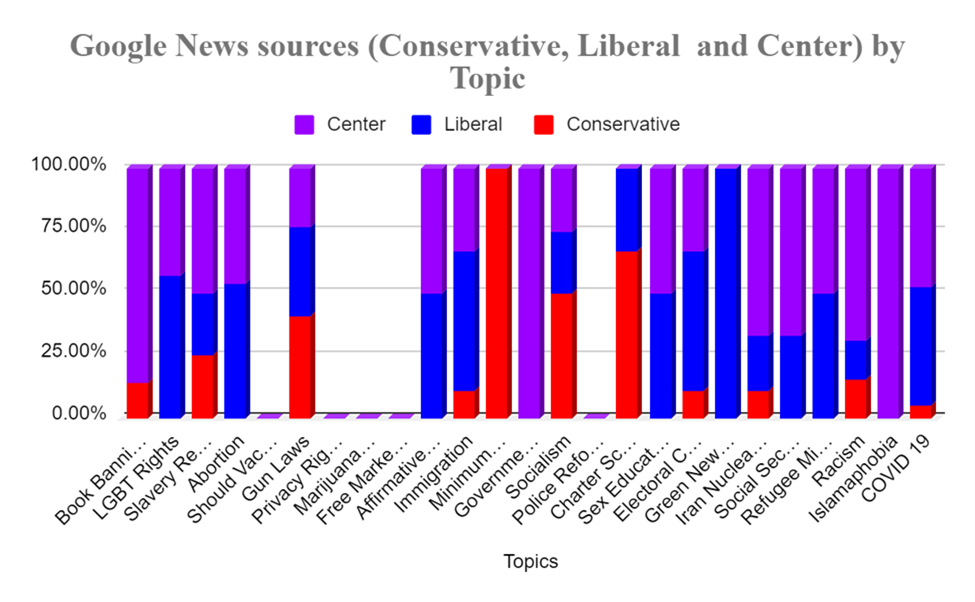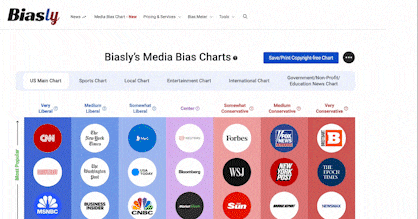
Today, algorithmic bias permeates news feeds across the internet. Friis and Riley’s Eliminating Algorithmic Bias Is Just the Beginning of Equitable AI defines algorithmic bias as “when algorithms make decisions that systematically disadvantage certain groups of people.” This poses a big problem for people online; it has caused people to develop biases and hindered self-expression unknowingly. That makes it imperative for everyone to understand where and how algorithmic bias manifests online. In this article, we will take a close look at the algorithmic bias on Google, Bing, and a variety of social media sites.
Algorithmic Bias on Google
One organization with algorithmic bias is Google. Google tends to show more liberal and conservative sources after political topics are searched. The article Is Google News Biased? reveals that Google has liberal and center biases, stating that “The analysis of Google News by Biasly, found that Google displayed articles from media sources rated as Liberal or Center more often and more prominently than media sources rated as Conservative.”

Source: Biasly
The article then takes a closer look at this trend by measuring the total appearances of multiple media sources in Google News. The author writes, “Liberal and Center sources dominated with only Fox News and WSJ making an appearance from Conservative outlets (2 out of 6)…”
Both of these studies reveal that in response to most search prompts, Google exposes users to more center and liberal sites than conservative ones. It amplifies center and liberal stances while muffling conservative stances.
Algorithmic Bias on Bing
Another search engine with an algorithmic bias is Bing.
- Bing tends to show more articles with a center or liberal bias after political topics are searched
- Bing tends to show more articles with a liberal bias after politicians are searched
In Bing Search Engine: A Review of its Media Bias, McCurdy states that “Bing Search results displays a Left-leaning bias…”

Source: Biasly
This is proven by Biasly’s chart above, which displays how when political subjects–such as healthcare reform and LGBTQ+ rights–are searched on Bing, most results have a center or liberal bias.
This bias also occurs with Bing’s search results for politicians. McCurdy notes, “Figures on the political left, such as Kamala Harris and Nancy Pelosi, were predominantly reported on by Left-leaning sources. This pattern was equally evident for staunch Right-Wing figures like Nikki Hayley and Mike Pence. This trend also applied to Centrist politicians like Lisa Murkowski and Joe Manchin.”

Source: Biasly
Since Bing mostly shows reports on politicians from left sources, its users are not often exposed to the various views that people across the political spectrum have on these politicians.
Algorithmic Bias on Social Media
Algorithmic bias is also found throughout social media. We will discuss its presence on several social media sites.
- Instagram has a setting that causes it to avoid showing all political content across the spectrum
- Facebook has had content influenced by political parties across the globe.
- TikTok develops an algorithmic bias based on the posts someone interacts with, as well as current events
One social media app with algorithmic bias is Instagram. According to Foreign Press USA’s Instagram’s Decision to Limit Political Content Sparks Debate:
“The company, owned by Meta, has put in place a setting to limit the political content being fed to users automatically.”
This hinders people who are trying to be heard on Instagram when they post about political subjects, like “voting information, reproductive rights, and advocacy for marginalized groups,” as the article lists. It describes how “users saw an increase in comments being hidden, captions being deleted, and hashtags being suppressed.” This setting is an act of algorithmic bias against all of those who make political content on the app.
A second site with algorithmic bias is Facebook. In The Negative Effects of Social Media Algorithms, Singer writes the following about Facebook: “The 2018 algorithm that focused on reshared materials from family and friends instead of professionally produced content’ increased the number of ‘misinformation, toxicity and violent content’ among users’ newsfeeds. Political parties took advantage of this, as those in Europe reportedly changed their policies to have more presence on the network. Without naming the specific political parties, an internal Facebook report stated that parties, even those feeding off the algorithm for their one benefit, ‘worry about the long-term effects on democracy.’” Political parties worldwide have influenced Facebook’s algorithm to make people develop biases in their favor. This may cause people who use the site to not see all sides of societal issues, which therefore puts them at risk of being misinformed.
Another example of algorithmic bias is TikTok. In the article, My Descent Into TikTok News Hell, Robertson recalls, “When I watched a live stream of House Speaker Kevin McCarthy railing about the debt ceiling at the NYSE (by this time, the app’s algorithmic engine was rolling), it gave me a heavy dose of Fox News’s Jesse Watters. When I yanked the tiller in the other direction with some Crooked Media videos, I got liberal comedian Jon Stewart and progressive former U.S. Secretary of Labor Robert Reich.” TikTok creates an algorithmic bias based on one’s activity. If someone engages with a conservative post, then the app will present more conservative content. The same applies to liberal posts. Therefore, depending on which videos the user interacts with, TikTok can develop an algorithmic bias toward either political side.
The app can also form an algorithmic bias based on current events. TikTok’s algorithm is highly sensitive – and could send you down a hate-filled rabbit hole before you know it, Taylor describes an experiment conducted by The Guardian on TikTok, writing:
“Guardian Australia set up a new TikTok account on a completely blank smartphone linked to a new, unused email address…We scrolled through the feed every couple of weeks.
For the first two days of the experiment, TikTok served up generic content about Melbourne, where the phone was located, along with videos about iPhone hacks – typical content one can expect on TikTok as an iPhone owner.
On day three, TikTok news content began appearing, coinciding with the stabbing attack on bishop Mar Mari Emmanuel…It wasn’t the video of the stabbing itself, but rather videos of Emmanuel’s evocative and conservative Christian sermons. Watching them appears to have triggered TikTok’s algorithm – more and more of his sermons were served up and conservative Christian videos began appearing one after the other.”
Even if you do not trigger an algorithmic bias on TikTok, you may still be involuntarily faced with one after watching content that the app gives you in response to events on the news.
Evidently, algorithmic bias is a major issue, no matter which site you visit on the internet. It can appear in search engines, as well as multiple forms of social media. This is a significant issue, since people may become biased without realizing it, and their voices are not being heard online. This is why everyone needs to be aware of when they encounter algorithmic bias and how it works on a variety of internet spaces.






















